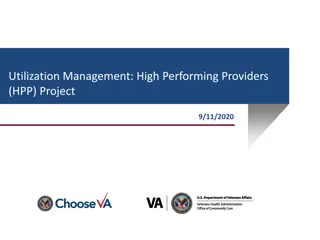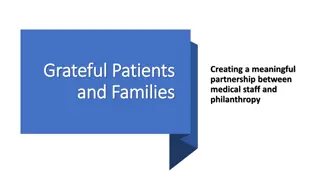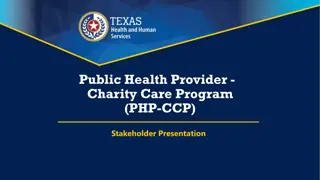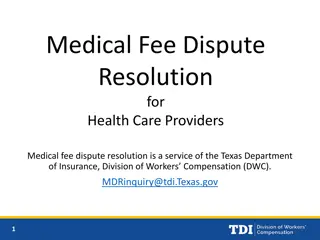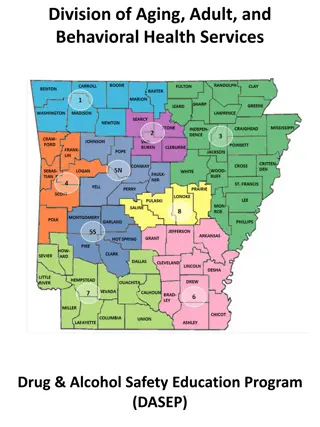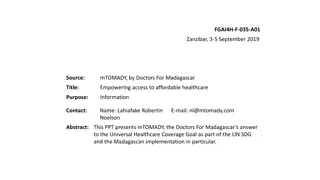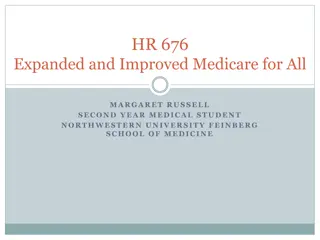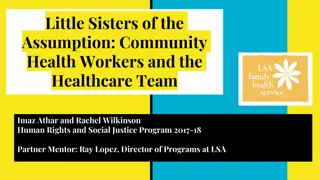Annual TB Education Overview for Healthcare Providers
"This PowerPoint template covers essential information on Tuberculosis (TB) for annual health care provider education, meeting CDC guidelines. It explains TB, Latent TB Infection (LTBI), and the differences between LTBI and TB Disease. Facilities must customize content before use to comply with regulations."
Download Presentation

Please find below an Image/Link to download the presentation.
The content on the website is provided AS IS for your information and personal use only. It may not be sold, licensed, or shared on other websites without obtaining consent from the author. Download presentation by click this link. If you encounter any issues during the download, it is possible that the publisher has removed the file from their server.
E N D
Presentation Transcript
USE OF POWERPOINT TEMPLATE AND DISCLAIMER This PowerPoint was designed as a template to cover the basic educational requirements for annual health care providers as outlined in CDC Tuberculosis, Screening, Testing, and Treatment of U.S. Health Care Personnel: Recommendations from the National Tuberculosis Controllers Association and CDC, 2019 and Guidelines for Preventing the Transmission of Mycobacterium tuberculosis in Health-Care Settings, 2005. All health care facilities are responsible for ensuring the annual TB education is in compliance with Oregon Administrative Rule and appropriate for their setting. This PowerPoint should be modified before use. In particular, text in red should be changed so it is specific to the facility. Contact Heidi Behm heidi.behm@state.or.us with suggestions to improve this template.
ANNUAL TB EDUCATION FOR HEALTHCARE PERSONNEL
WHAT IS TUBERCULOSIS? Tuberculosis (TB) is caused by a bacteria called Mycobacterium Tuberculosis. The bacteria usually attack the lungs (pulmonary TB) but it can attack any part of the body, such as the kidney, spine, and brain (extrapulmonary TB). If not treated TB disease can be fatal. Not everyone infected with TB bacteria becomes sick. There are two TB-related conditions, TB Disease and Latent TB Infection (LTBI).
WHAT IS LATENT TB INFECTION (LTBI)? TB bacteria can live in the body without making you sick. This is latent TB infection (LTBI). When most people breathe in TB bacteria and become infected, the body fights the bacteria to stop them from growing. People with LTBI: Have no symptoms. Don t feel sick. Can t spread TB to others. Usually have a positive TB skin test reaction or positive TB blood test. May develop TB disease if they are not treated for LTBI. Many people with LTBI never develop TB disease. The TB bacteria may remain inactive for a lifetime. But for some people, especially people with a weak immune system, the bacteria become active, multiply, and cause TB disease.
LATENT TB INFECTION (LTBI) VS TB DISEASE Person with Latent TB Infection Person with TB Disease TB screening test (TST or IGRA): positive TB screening test (TST or IGRA): typically positive Chest x-ray: Normal Chest x-ray: Typically abnormal and positive sputum smear/culture TB bacteria: Live but inactive TB bacteria: Active Symptomatic: coughing, fever, night sweats, weight loss, chest pain Asymptomatic Non-infectious Infectious *From the CDC website pdf: TB Elimination The Difference Between Latent TB Infection and TB Disease
TB SCREENING FOR NEW EMPLOYEES If you tested negative for LTBI in the past, you will be screened by (add screening method at your facility, Quantiferon, TSPOT or two step TB skin test). If the screening test is positive, you will need a chest x-ray. This will be provided at no charge to you. All new employees must complete a Baseline TB Risk Assessment and TB Symptoms form (change to name of form at your facility)
ANNUAL TB SCREENING FOR EMPLOYEES WHO HAVE UNTREATED LTBI Employees with LTBI that do not take treatment will be screened annually for symptoms of TB disease.
DO YOU HAVE TB SYPMTOMS? Coughing for 3 weeks or longer Hemoptysis (coughing up blood) Chest pain Unexplained weight loss Loss of appetite Night sweats Fever Fatigue Chills
INDIVIDUAL RISK ASSESSMENT If you were exposed to TB at work or outside of work, discuss this with Occupational Health or your primary care provider to determine if testing is needed. You are considered to be at increased risk for TB if you: 1. Resided (for 1 month) in a country with a high TB rate (i.e., any country other than Australia, Canada, New Zealand, the United States, and those in western or northern Europe). 2. Are currently or will be immunosuppressed. Immunosuppression includes HIV/AIDS, organ transplant, treatment with a TNF-alpha antagonist (e.g., infliximab, etanercept, or other), chronic steroids (equivalent of prednisone 15 mg/day for 1 month), or other immunosuppressive medication. 3. Were a close contact to someone with infectious TB disease since the last TB test (unless adequate PPE was utilized).
INFECTION CONTROL If a patient has symptoms of TB disease, airborne isolation should be instituted: Patients with a cough should wear a surgical or procedure mask. Healthcare personnel should wear a respirator (N95 or PAPR) while caring for the symptomatic patient to prevent inhalation of airborne bacteria. FACILITY ADD INFO ABOUT HOW YOU WILL TRIAGE. If you develop symptoms of TB disease: Put on mask if coughing or other symptoms are present. Notify your primary care provider and Occupational Health ASAP. Do not report to work until cleared by Occupational Health.
TREATMENT OF LATENT TB INFECTION 5-10% of people with LTBI develop TB disease at some time in their lives. About half of people who develop TB disease do so within the first two years of infection. In the U.S., up to 13 million people may have LTBI. More than 80% of people who get sick with TB disease each year get sick from untreated LTBI. LTBI treatment is simple and can usually be completed in a few months. LTBI treatment is shorter, simpler, and better tolerated than in the past. Most new cases of TB disease are from activation of LTBI. Treatment of latent TB infection is strongly recommended!
Treatment Options for Latent TB (LTBI) Isoniazid/Priftin (3HP) Isoniazid/Rifampin (3HR) Rifampin (4R) Drug Regimen Length of Treatment 3 months 3 months 4 months How often do you take medication? Once a week Daily Daily How many doses? Pills taken at a time 12 doses of 9 tablets 90 doses of 3 pills 120 doses of 2 pills Expected Side Effect Orange-red colored urine/saliva/tears/sweat Possible Side Effects Mild fatigue, nausea, jaundice, tingling, rash, headache
Employees with LTBI who have TB Disease Symptoms It is essential anyone with untreated LTBI who has a cough for longer than 3 weeks, fever, night sweats, weight loss or other symptoms of TB disease, report to (ADD FACILTY NAME) Occupational Health to prevent the spread of TB. I ATTEST THAT IF I HAVE LATENT TB INFECTION WHICH HAS NOT BEEN TREATED AND SYMPTOMS OF TB DISEASE, I WILL REPORT THIS TO OCCUPATIONAL HEALTH AND MY HEALTHCARE PROVIDER.
CHECK YOUR KNOWLEDGE T or F 1. Tuberculosis disease only occurs in the lungs. T or F 2. Tuberculosis disease can be fatal if not treated. T or F 3. Latent tuberculosis infection is contagious. T or F 4. Treatment of latent tuberculosis infection is strongly recommended. T or F 5. Treatment options for LTBI are shorter and simpler than in the past. T or F 6. I need to report possible TB symptoms or exposures.
QUIZ ANSWERS 1. Tuberculosis disease only occurs in the lungs. False, TB can occur in locations outside the lung such as brain, spine, kidney, & more. 2. Tuberculosis disease can be fatal if not treated. True, TB is the leading cause of infectious disease death in the world. 3. Latent tuberculosis infection is contagious. False, latent TB infection is not infectious, TB disease is infectious. 4. Treatment of latent tuberculosis infection is strongly recommended. True, treatment is highly effective in preventing TB disease. 5. Treatment options for LTBI are shorter and simpler than in the past. True, newer regimens are simpler, well tolerated and only 3-4 months. 6. I need to report possible TB symptoms or exposures. True, TB tests are not done annually, report possible TB symptoms or exposures.








